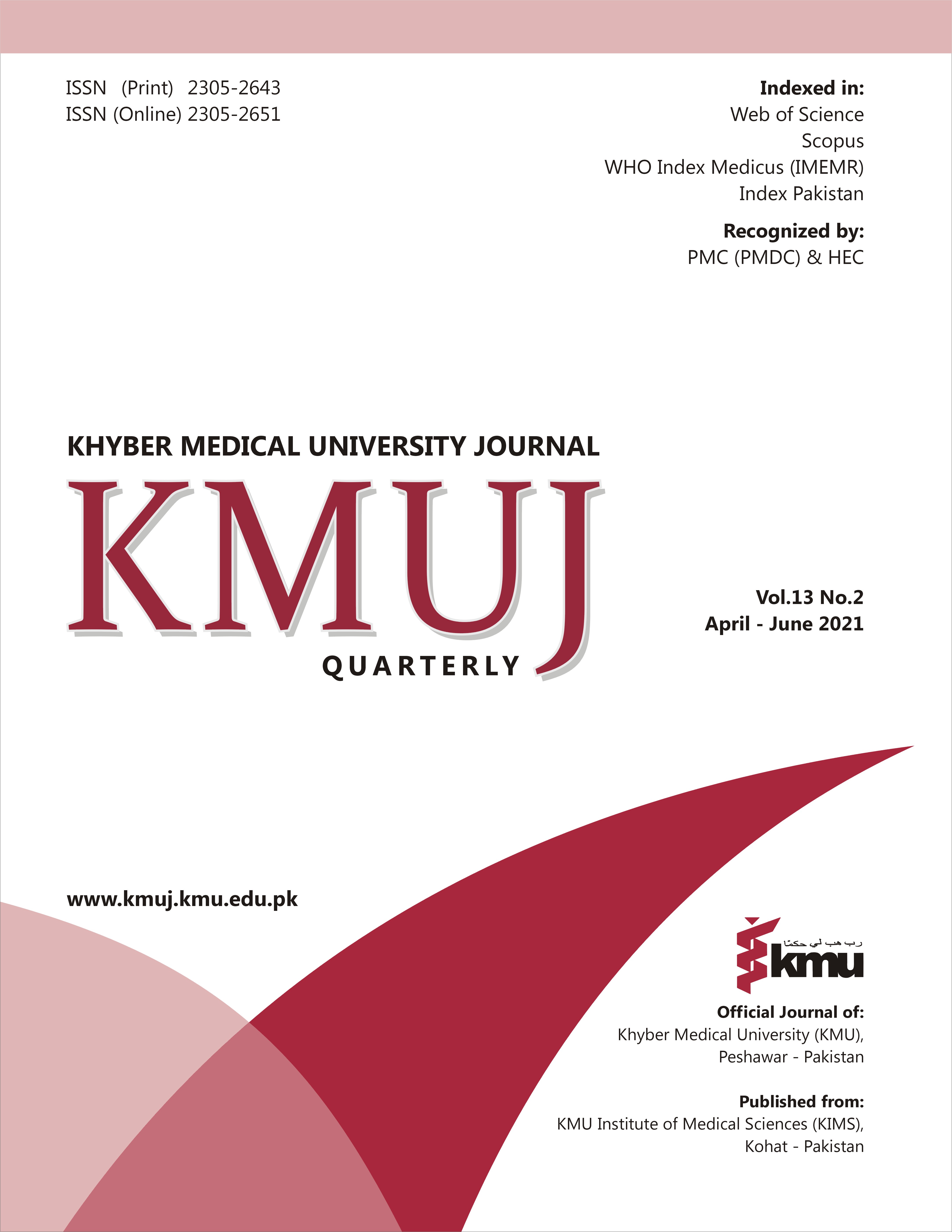COMMUNITY PARTICIPATION IN PREVENTION OF COMMUNICABLE DISEASES IN RURAL AREAS OF PAKISTAN: A REVIEW OF LITERATURE
Main Article Content
Abstract
BACKGROUND: There is huge burden of both communicable and non-communicable diseases in healthcare systems. Community engagement is the diverse beneficial relationship between community stakeholders, primary healthcare system and professionals over a wide variety of tasks, their role and participation in decision making for enhancing community health.
OBJECTIVES: This paper focuses to present the use of Ladder of Community Participation as a framework to integrate community health problems in Pakistan. Additional focus is on local issues and the integration of the model according to socio-politico-economic structure of Pakistan
METHODS: Research articles were reviewed from PubMed, Medline, EBSCO, and CINAHL. Different key words such as “community engagement”, “community participation”, “communicable diseases”, “Ladder framework”, were used along with focus on the most recent and human based studies. After thorough review of the abstracts, selected researches were used to integrate the concept of community engagement in prevention of communicable diseases.
REVIEW: Review of the literature showed that local healthcare services alone cannot make sufficient efforts to uplift the health status of the communities. Community based collaborative interventions are often cost effective, sustainable and effective in managing outbreaks and other communicable diseases. It is imperative to engage the local communities and its stakeholders for an informative, collaborative and success oriented approach. Moreover, educating the community stakeholders for on-going basis can be an asset to the public health initiatives in the community. The ladder of community participation presented in this paper guides the public health workers and community stakeholders for step-wise integration of community and its resources in different programs about communicable disease prevention.
CONCLUSION: This ladder presents a continuum of different approaches, which will help in planning program management, feasibility assessment, evaluating ongoing interventions along with modification, and expanding community engagement approaches.
Article Details
Work published in KMUJ is licensed under a
Creative Commons Attribution 4.0 License
Authors are permitted and encouraged to post their work online (e.g., in institutional repositories or on their website) prior to and during the submission process, as it can lead to productive exchanges, as well as earlier and greater citation of published work.
(e.g., in institutional repositories or on their website) prior to and during the submission process, as it can lead to productive exchanges, as well as earlier and greater citation of published work.
References
Robinson HM, Hort K. Non-communicable diseases and health systems reform in low-and-middle-income countries. Pac Health Dialog 2012;18(1):179-90.
Ndiaye SM, Quick L, Sanda O, Niandou S. The value of community participation in disease surveillance: a case study from Niger. Health Promot Int 2003;18(2):89-98. https://doi.org/10.1093/heapro/18.2.89
Haldane V, Chuah FL, Srivastava A, Singh SR, Koh GC, Seng CK, et al. Community participation in health services development, implementation, and evaluation: A systematic review of empowerment, health, community, and process outcomes. PLoS One 2019;14(5):e0216112. https://doi.org/10.1371/journal.pone.0216112
Nojilana B, Bradshaw D, Pillay-van Wyk V, Msemburi W, Laubscher R, Somdyala NI, et al. Emerging trends in non-communicable disease mortality in South Africa, 1997-2010. S Afr Med J 2016;106(5):58. https://doi.org/10.7196/SAMJ.2016.v106i5.10674
Adhikari B, Pell C, Phommasone K, Soundala X, Kommarasy P, Pongvongsa T, et al. Elements of effective community engagement: lessons from a targeted malaria elimination study in Lao PDR (Laos). Glob Health Action 2017;10(1):1366136. https://doi.org/10.1080/16549716.2017.1366136.
Morgan MA, Lifshay J. Community engagement in public health. California Endowment under the sponsorship of Contra Costa Health Services (CCHS). 2006: 1-8.
Aggett S. Turning the gaze: challenges of involving biomedical researchers in community engagement with research in Patan, Nepal. Crit Public Health 2018;28(3):306-17. https://doi.org/10.1080/09581596.2018.1443203.
Abramsky T, Devries K, Kiss L, Nakuti J, Kyegombe N, Starmann E, et al. Findings from the SASA! Study: a cluster randomized controlled trial to assess the impact of a community mobilization intervention to prevent violence against women and reduce HIV risk in Kampala, Uganda. BMC Med 2014;12(1):122. https://doi.org/10.1186/s12916-014-0122-5.
Waddington H, Snilstveit B, White H, Fewtrell L. Water, sanitation and hygiene interventions to combat childhood diarrhea in developing countries. New Delhi, India: 3ie; 2009 Aug [Accessed on: February 15, 2020] Available from URL: http://www.3ieimpact.org/evidence/systematic-reviews/details/23/.
Oliver JE, Wood T. Medical conspiracy theories and health behaviors in the United States. JAMA Intern Med 2014;174(5):817-8. https://doi.org/10.1001/jamainternmed.2014.190
Demaio AR, Nielsen KK, Tersbøl BP, Kallestrup P, Meyrowitsch DW. Primary Health Care: a strategic framework for the prevention and control of chronic non-communicable disease. Glob Health Action 2014;7(1):24504. https://doi.org/10.3402/gha.v7.24504
Theodori GL. Community and community development in resource-based areas: Operational definitions rooted in an interactional perspective. Soc Nat Resour 2005;18(7):661-9. https://doi.org/10.1080/08941920590959640
Mir F, Mahmood F, Siddiqui AR, Baqi S, Abidi SH, Kazi AM, et al. HIV infection predominantly affecting children in Sindh, Pakistan, 2019: a cross-sectional study of an outbreak. The Lancet Infect Dis 2020;20(3):362-70. https://doi.org/10.1016/S1473-3099(19)30743-1
Chandio SP, Talpur GH, Rajput MI. Prevalence of Hepatitis-D in Rural Sindh, Pakistan. Univ Sindh J Animal Sci 2018;2(02):45-7.
Lavery JV, Tinadana PO, Scott TW, Harrington LC, Ramsey JM, Ytuarte-Nuñez C, et al. Towards a framework for community engagement in global health research. Trends Parasitol 2010;26(6):279-83. https://doi.org/10.1016/j.pt.2010.02.009
Sannathimmappa MB, Nambiar V, Arvindakshan R. Hepatitis B: Knowledge and awareness among preclinical year medical students. Avicenna J Med 2019;9(2):43-7. https://doi.org/10.4103/ajm.AJM_164_18
Whittaker M, Smith C. Reimagining malaria: five reasons to strengthen community engagement in the lead up to malaria elimination. Malar J 2015;14(1):410(2015).
https://doi.org/10.1186/s12936-015-0931-9
Rich KL. Community/Public Health Nursing Ethics. In: Nursing Ethics, Across the Curricullum and Into Practice. Butts JB, Rich KL (eds). 2020, 5th edition. Jones and Bartlett Learning. Burlington, USA.
Nyirenda D, Sariola S, Gooding K, Phiri M, Sambakunsi R, Moyo E, et al. ‘We are the eyes and ears of researchers and community’: Understanding the role of community advisory groups in representing researchers and communities in Malawi. Dev World Bioeth 2018;18(4):420-8. https://doi.org/10.1111/dewb.12163
